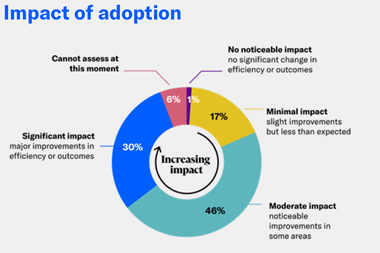Most insurance professionals would agree that the hard market for directors' and officers' (D&O) insurance in the US reached its peak at some time in 2003. But this latest hard market cycle brought more than just an increase in the premiums that are now slowly returning to soft-market levels.
The D&O market in the US has gone through some evolutionary changes, changes that will continue for the foreseeable future, even if prices continue to fall. Those changes include:
- different views on how to structure a D&O insurance programme
- what policy wordings are essential to consider for the primary-layer D&O insurance in a programme
- closer scrutiny being paid to the wordings in 'follow form' excess policies, regardless of the programme structure used
- the explosion in the use of excess/difference-in-conditions (DIC) Side A insurance.
Taking a fresh look at programme structure options
Given all that has transpired in D&O insurance since mid-2002, more companies are holding pre-renewal strategy meetings with their brokers about four to six months prior to renewal. Such a meeting typically focuses on the programme structure that the company wants to put in place, or at least consider.
The need to make such a strategy decision with respect to macro programme structure issues has become necessary, given the changes resulting from the hard D&O insurance market. These include the constriction in policy wordings for traditional D&O insurance, and the dramatic increase in availability of very broad excess/DIC Side A insurance.
The traditional D&O insurance policy provides coverage for:
- claims against directors and officers where such claims are not indemnified by the company (ie Side A insurance)
- a company's indemnity obligations to directors and officers for claims made against them (ie Side B, or corporate indemnification, insurance).
A traditional D&O policy might also provide coverage for securities claims, as defined in the policy, against the company (ie Side C, or entity, insurance).
The Side A coverage in several of the excess/DIC Side A policies that are readily available in the US for all size companies at all types of attachment points (as low as $5m) is dramatically broader than the Side A coverage in traditional D&O insurance marketed in the US. This was not the case before 2002, and presents companies with a new consideration when thinking about the type of D&O insurance programme they should procure.
The first question that must be asked at the renewal strategy meeting is why is the company buying D&O insurance? Is it buying 'balance sheet protection' or 'personal asset protection' - or both?
If the only reason the company is buying D&O insurance is to protect the personal assets of its directors and officers, then the optimal programme structure may be to buy only excess/DIC Side A insurance, and not buy traditional D&O insurance at all. Indeed, several very large companies have adopted that approach in the past two years.
On the other hand, if one of the reasons the company is buying D&O insurance is to protect its balance sheet (ie to insure the company's indemnity obligations to directors and officers, as well as securities claims against the company), then it should continue to buy traditional D&O insurance.
In most instances it should also buy excess/DIC Side A insurance.
Policy wording issues
The rules of the game have not only changed with respect to macro programme structuring issues. Those companies that decide to continue to buy traditional D&O insurance need to pay special attention to new and critical policy wording issues.
There are more than 20 issues to consider negotiating in any primary-layer traditional policy. However, two of the most important issues are 'personal conduct' exclusions and severability.
A lot of attention has been paid to the personal conduct (fraud, dishonesty and profit/advantage) exclusions since mid-2002. Many insurers have formulated their own corporate-wide wordings, so these exclusions can vary, including the 'trigger' of the exclusion - what must happen in order for the exclusion to apply (and also what can happen to make the exclusion not apply). The most commonly-used triggers are:
- 'FINAL ADJUDICATION' TRIGGER - applying the exclusion only if the excluded conduct is proven to have occurred in the underlying claim
- 'FINAL DETERMINATION' TRIGGER - applying the exclusion only if it is determined in some court proceeding or binding arbitration (whether in the underlying claim or separate coverage action) that the excluded conduct occurred
- 'ADMISSION' TRIGGER - applying the exclusion if it is admitted that excluded conduct occurred. Exclusions using the admission standard vary significantly. Some apply only to the insured who admitted that he/she committed the excluded conduct. Some apply if any insured admits that the excluded conduct occurred (it is not clear how the concept of severability applies to such wording). Some apply only if the admission was made in writing. And some apply whether the admission was oral or in writing.
This admission trigger is usually combined with another trigger, so that the exclusion applies either in the case of admission or final adjudication/determination
- 'IN FACT' TRIGGER - applying the exclusion if the excluded conduct 'in fact' occurred without expressly referencing adjudication in any proceeding or an admission by an insured.
Depending upon a number of factors, some companies might prefer a final determination trigger over a final adjudication trigger. And some companies might be forced to take an admission or in fact trigger in the policy sold by the carrier they want to use as their primary-layer D&O carrier.
It is important to fully understand the wording differences in these exclusions so that companies can make an informed decision when structuring their D&O insurance programme.
Much attention has been paid to severability as to the application and an insurer's right to rescind the policy in the last year, especially given various recent 'white papers' that are circulating, and the fact that one or more carriers introduced new severability wordings into the market in October/November 2003 and then again in September/October 2004.
It used to be the consensus among insurance professionals that if the policy provided for 'full severability' as to the application for insurance, the insurer could not rescind the policy as to any insured who did not have knowledge of a misstatement in or omission from the application for insurance. Unfortunately, in 2002 and 2003, some insurers took the position in coverage litigation that full severability is meaningless in a variety of circumstances, and sought to rescind policies with full severability clauses as to all insureds, even those who did not know of any misstatement in or omission from the application.
Indeed, the law of many US states permits insurers to rescind an insurance policy for any material misstatement in, or omission from, the application, whether or not the insured knowingly made such misstatement or omission.
In those states, a policy that merely provides full severability as to the application may not provide full protection for innocent insureds.
An insured should understand the state law that will apply to the interpretation of its D&O insurance policy, and that state's law on rescission of an insurance policy. If that analysis leads to the conclusion that the insurer can rescind the policy for any material misstatement in or omission from the application, regardless of the insured's knowledge, the insured should consider seeking express rescission language in the D&O policy. The two most popular clauses are:
- an absolute non-rescission clause, with the policy expressly stating that the Side A coverage cannot be rescinded by the insurer under any circumstances
- a severability with express statement regarding rescission, with the policy expressly stating that, with respect to the application for insurance, no statements made or knowledge possessed by one insured shall be imputed to another insured person. The policy also expressly states that the Side A coverage cannot be rescinded as to any insured person who did not have knowledge of any misstatement in or omission from the application that otherwise gives rise to the insurer's right to rescind the policy.
Finally, when reviewing severability as to the application wording, it is important to understand that the wording in a primary-layer, traditional D&O policy can be different for the insured persons covered by the Side A part of the policy to the coverage for the company under the Side B and/or Side C parts of the policy. For example, some policies provide full severability as between insured persons for Side A coverage, but no severability for the company, so that if any insured person (which in some policies includes non-director/non-officer employees) knows of something, that knowledge can be imputed to the company to rescind the policy as to the company for Side B and/or Side C coverage.
Excess 'follow form' issues
Another result of the hard D&O market was that more risk managers asked their brokers, and sometimes outside lawyers, to look more carefully at so-called 'follow form' excess policies in 2003 and 2004. The price for even excess D&O insurance had increased so much that they wanted to be certain they were buying a D&O insurance programme that had concurrent terms from the primary to the highest-level excess.
Many risk managers found that so-called follow form policies differ, sometimes significantly, from one carrier to the next. If there are any non-concurrent provisions in any of the excess policies used in a D&O insurance programme, gaps in coverage could exist. Such gaps could affect only the balance sheet protection afforded to the company, or also affect the asset protection afforded to the company's directors and officers, so risk managers need to pay attention to the provisions in excess follow form policies.
Excess/DIC Side A issues
The US has experienced an explosion in the purchase of excess/DIC Side A insurance by larger middle market companies. The demand appears to be coming from two sources:
- directors and officers who know and understand that the Side A coverage in a broadly-worded excess/DIC Side A policy is much broader than Side A coverage in a traditional D&O policy
- risk managers who are proactive in ensuring that some of the Side A coverage in their programme is the broadest available (because they are attempting to create a D&O programme that will help attract or retain high-quality independent directors).
This growth in uptake is reflected by the number of carriers now offering this coverage. In January 2003 there was really only one insurer in the US marketing the cover (although the Bermuda insurer CODA, a subsidiary of ACE, has offered excess/DIC Side A insurance to US-based companies for years), but by the end of 2004 there will be about 15 insurers in the US offering excess/DIC Side A insurance.
But is all excess/DIC Side A insurance created equal? No, not even close.
Indeed, and unfortunately, several of the newer excess/DIC Side A forms coming onto the market do not have the key features that make a D&O policy a 'true' excess/DIC Side A policy (ie one that has much broader coverage than provided by the Side A insurance in a traditional D&O policy). Accordingly, insurance professionals need to know what to look for, in such policies.
Consider the changes
The latest hard market cycle to hit D&O insurance in the US has turned out to be substantially more than a traditional one. It has had ramifications for D&O insurance that will affect the market for years to come. They include new ways to think about overall D&O insurance programme structuring, the different types of D&O insurance policies to buy, and the different wordings that should be negotiated in primary and excess policies. Risk professionals need to understand these changes and their implications.
Michael Rossi is president of Insurance Law Group, E-mail: mrossi@inslawgroup.com



















